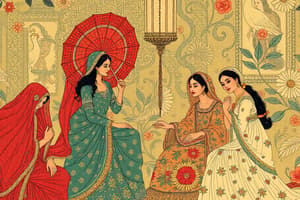Podcast
Questions and Answers
Why did the reformers take up the cause of emancipation of women?
Why did the reformers take up the cause of emancipation of women?
The reformers believed in social equality and justice, and recognized the need to empower women who were marginalized and oppressed.
What was the condition of widows prior to the reform movements?
What was the condition of widows prior to the reform movements?
Widows were treated as social outcasts, deprived of basic rights and often faced discrimination and neglect.
What was the contribution of Raja Rammohun Roy in women reforms?
What was the contribution of Raja Rammohun Roy in women reforms?
Raja Rammohun Roy advocated for women's education and spoke against social evils like Sati, promoting progressive ideas for the upliftment of women.
How did Vidyasagar succeed in bringing reforms for widows?
How did Vidyasagar succeed in bringing reforms for widows?
How was Pandita Ramabai different from women of her age?
How was Pandita Ramabai different from women of her age?
What do you mean by the Sati System prevalent in the society?
What do you mean by the Sati System prevalent in the society?
Flashcards
Why did reformers support women's emancipation?
Why did reformers support women's emancipation?
Reformers championed women's emancipation because they recognized the injustices and oppression faced by marginalized women, and they believed in social equality.
Condition of widows before reforms?
Condition of widows before reforms?
Prior to reforms, widows were often treated as outcasts, facing deprivation, discrimination, neglect, and a lack of basic rights within society.
Raja Rammohun Roy's contribution?
Raja Rammohun Roy's contribution?
Raja Rammohun Roy advocated for women's education, spoke against Sati, and promoted progressive ideas to uplift women in society.
Vidyasagar's reforms for widows?
Vidyasagar's reforms for widows?
Signup and view all the flashcards
How was Pandita Ramabai unique?
How was Pandita Ramabai unique?
Signup and view all the flashcards
What was the Sati System?
What was the Sati System?
Signup and view all the flashcards
Study Notes
Women's Life in 19th Century India
- Women's life in 19th century India was marked by social evils like Sati System, child marriage, and limited education and employment opportunities.
The Sati System
- The Sati System was a practice in which a widow would immolate herself on her husband's funeral pyre.
Brahmo Samaj
- The Brahmo Samaj was a socio-religious reform movement founded by Raja Rammohun Roy.
Social Evils of 19th Century India
- Social evils prevalent in 19th century India included the Sati System, child marriage, and restrictions on women's education and employment.
Widow Remarriage Act, 1856
- The Widow Remarriage Act, 1856, was a legislation that allowed widows to remarry.
- The act was a result of struggles by reformers who sought to bring about change in the status of women.
Pandita Ramabai
- Pandita Ramabai was a prominent Indian woman who struggled for women's rights and education.
- She was different from women of her age due to her progressive views and efforts to bring about change.
Raja Rammohun Roy's Contribution
- Raja Rammohun Roy contributed to women's reforms by founding the Brahmo Samaj, which aimed to end social evils like the Sati System.
Vidyasagar's Reforms for Widows
- Vidyasagar succeeded in bringing reforms for widows by advocating for their rights and education.
- His efforts led to the passage of the Widow Remarriage Act, 1856.
Condition of Widows
- Prior to the reform movements, widows were subjected to social ostracism, forced to shave their heads, and were not allowed to remarry.
Studying That Suits You
Use AI to generate personalized quizzes and flashcards to suit your learning preferences.




